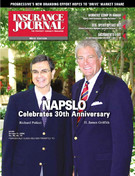Myths about the E&S market should not prevent homeowners from securing high-quality coverage. High-quality nonadmitted markets can provide consistent, reliable coverage for high-value and high-risk properties.
Even before Charley and Frances, insurers were fleeing the homeowners market for high-risk properties at an alarming pace. Over the last several years, large catastrophe and mold losses have caused a number of insurers to dramatically trim, and in many cases, deny coverage for homes in disaster-prone areas. The devastating 2004 hurricane season will likely exacerbate the situation – with months of hurricane season still to come, property/casualty insurers are already facing their costliest year since 2001.
It’s probable that weaker insurers lacking in capacity will be unable or unwilling to insure high-value homes, coastal residences and other high-risk properties in the coming months. As a result, individual homeowners may have difficulty securing vital coverage and find themselves absorbing the potentially devastating costs of replacing or rebuilding property.
Agents and homeowners must align themselves with carriers with the financial fortitude and market commitment to deliver for the long term, through both fair weather and heavy storms. They would be wise to take a good, hard look at an option they may have overlooked in the past: the nonadmitted market.
Outdated notions about everything from the financial strength of nonadmitted markets to the regulation of excess and surplus lines carriers have kept many from considering this market for homeowners risks. However, as many agents who have moved business to the nonadmitted sector understand, the old stereotypes surrounding the E&S market are just that: old stereotypes. Here’s the reality:
Superior financial strength resides in the nonadmitted market, including a carrier with the highest financial strength and long-term debt ratings available. Contrary to popular belief, E&S carriers do not have a higher risk of financial failure compared to admitted insurers. The latest A.M. Best report confirms that the solvency record of surplus lines insurers is comparable to that of the property/casualty industry as a whole. Therefore, rather than judging a carrier based on admitted or nonadmitted status, those seeking financial stability should focus on superior ratings.
Financial strength and long-term debt ratings are pivotal benchmarks of a carrier’s future viability. Many insurance buyers are surprised to uncover substantial disparities between the two ratings. In fact, some carriers that hold financial strength ratings of “A-” also have long-term debt ratings nearly below investment grade. Therefore, both ratings should be scrutinized when assessing any insurance carrier.
Policies that come with the highest financial strength and credit ratings available may cost more, but they can prove invaluable to a homeowner seeking lasting security. While small, local insurance companies may offer cheaper premiums, they are also more vulnerable to financial volatility.
The E&S market can handle both traditional and hard-to-place risks. Anyone seeking broad, tailored homeowners coverage for typical or atypical risks can benefit from the flexibility in rate and form provided by E&S carriers.
State guaranty funds do not provide guaranteed safety nets for all admitted market insureds. Although state guaranty funds were designed to pay claims for insolvent admitted carriers, numerous restrictions impede their ability to do so for mid- to high-value homeowners. For instance, many state funds can pay only as much as $300,000 on a single claim, far less than what’s needed to rebuild a high-value home.
Nonadmitted markets are proving loyal to homeowners through thick and thin. At least one nonadmitted carrier has been serving the homeowners market – including coastal and other high-risk properties – for more than a decade.
The stability of the E&S market is enhanced by close regulation captured in numerous reporting requirements and state regulations. The E&S market is also highly transparent. For example, almost every state maintains a “White List” of nonadmitted carriers deemed to be “in good standing” and permitted to do business in the state. Listed carriers are judged by various criteria, including claims-paying practices.
The message is clear: high-quality nonadmitted markets can provide consistent, reliable coverage for high-value and high-risk properties. Out-of-date myths about the E&S market should not prevent homeowners from securing high-quality coverage. Agents should not wait until another big storm makes a new spate of homeowners nonrenewals – or worse, carrier insolvencies – inevitable. Investigate nonadmitted market options now.
Lexington Insurance Company, as a nonadmitted carrier, has been steadfast in insuring mid- to high-value homes, including high-risk properties, for more than a decade. Lexington holds the highest financial strength rating from A.M. Best and our parent company, American International Group Inc. (AIG), has the highest long-term debt rating available. We’re making today’s crisis in homeowners insurance a non-event for agents and homeowners everyday.
John F. Moran CPCU, has been in the insurance industry for over a decade. He is currently vice president of Lexington Insurance Company’s personal lines division. For more information, please visit www.LexElite.com or e-mail Moran at John.Moran@aig.com.
Was this article valuable?
Here are more articles you may enjoy.


 Court Orders Justice Family Coal Companies to Pay $1M to Liberty Mutual Unit
Court Orders Justice Family Coal Companies to Pay $1M to Liberty Mutual Unit  Wildfires, Storms Fuel 2025 Insured Losses of $108 Billion: Munich Re Report
Wildfires, Storms Fuel 2025 Insured Losses of $108 Billion: Munich Re Report  CEOs on Guard as Trump Rattles Companies With Series of Edicts
CEOs on Guard as Trump Rattles Companies With Series of Edicts  Supreme Court Rejects Challenge to $2.46B Boy Scouts Sex Abuse Settlement
Supreme Court Rejects Challenge to $2.46B Boy Scouts Sex Abuse Settlement 


